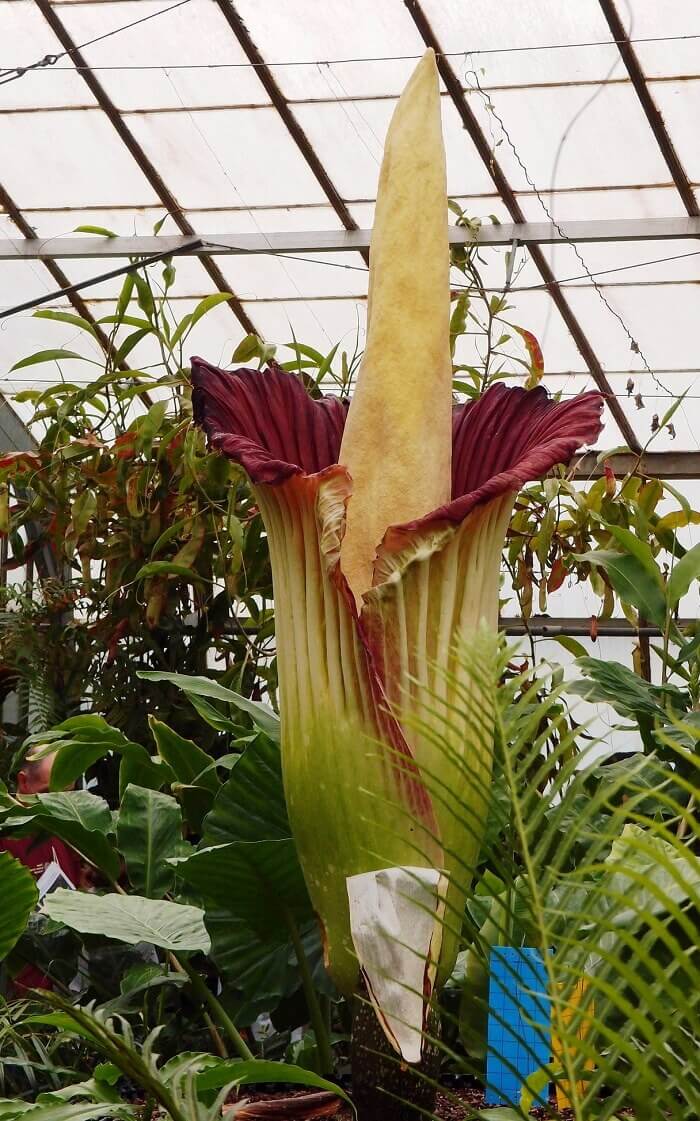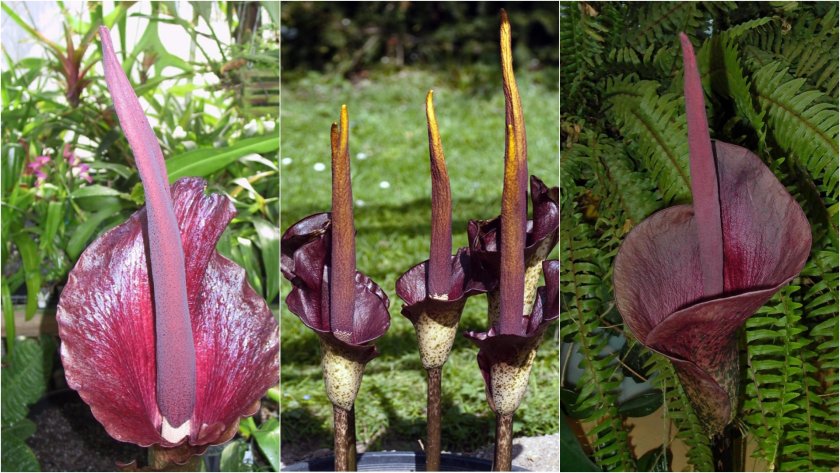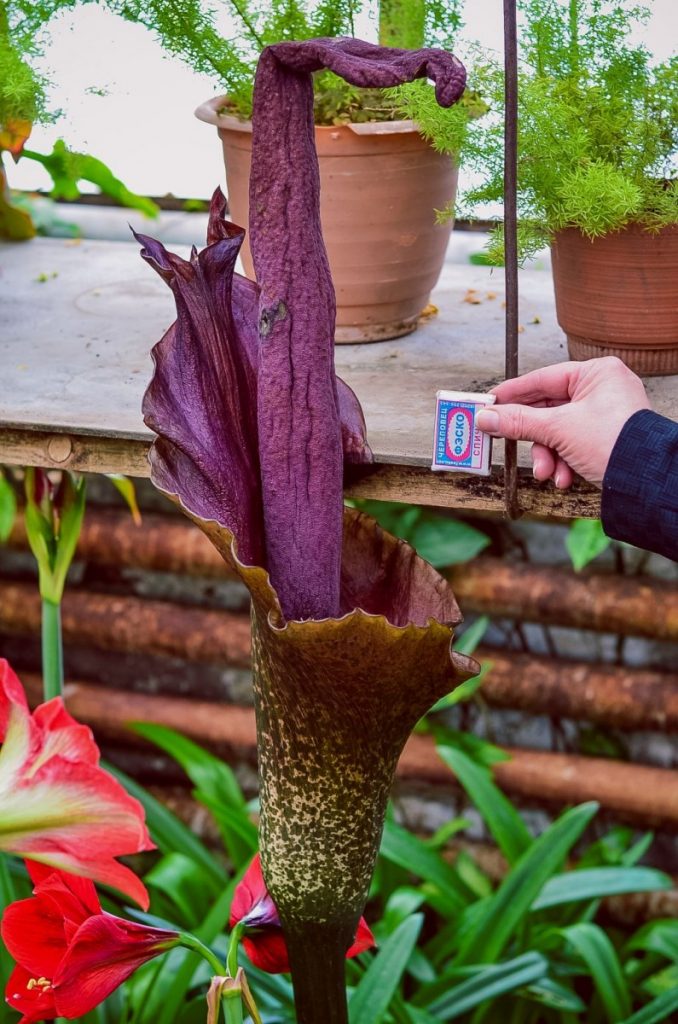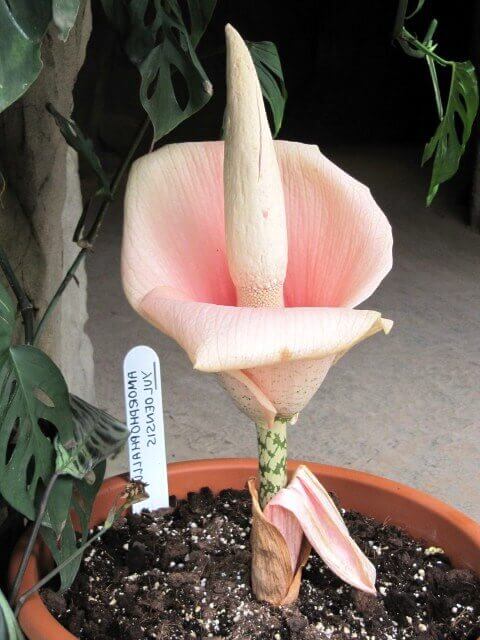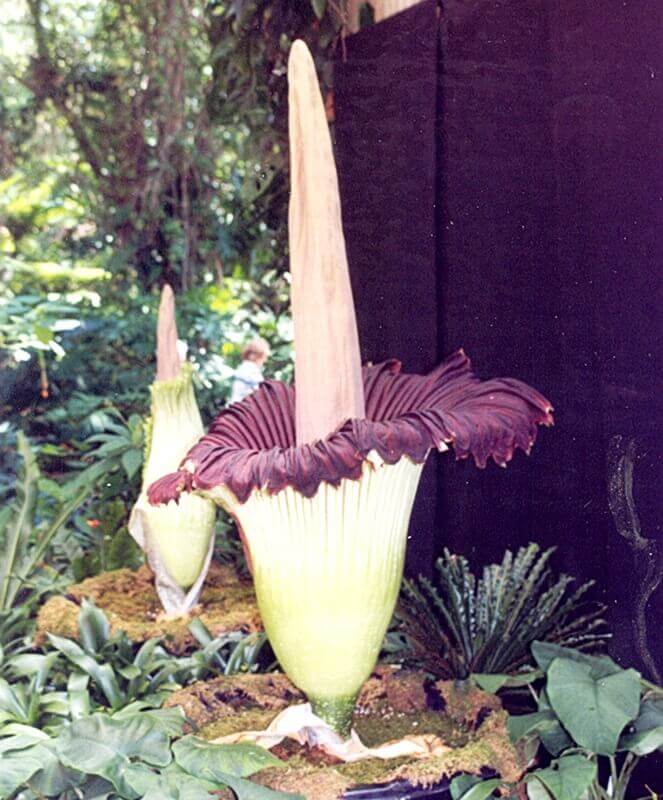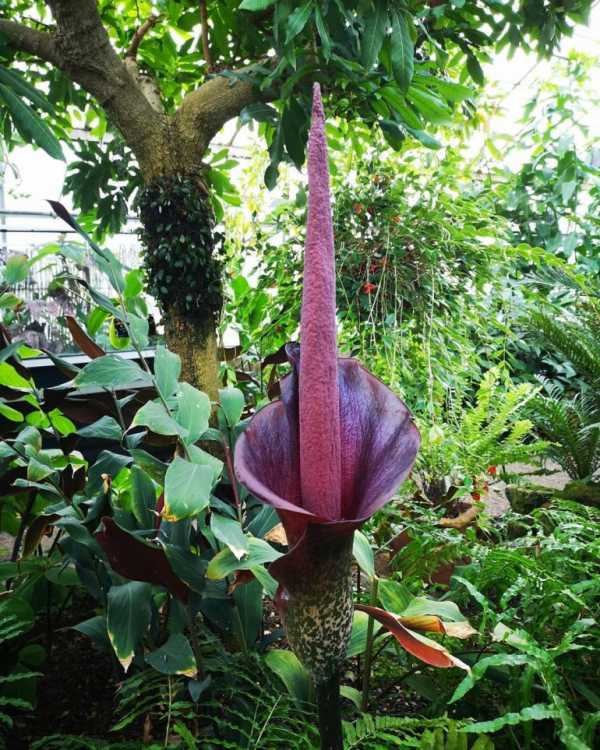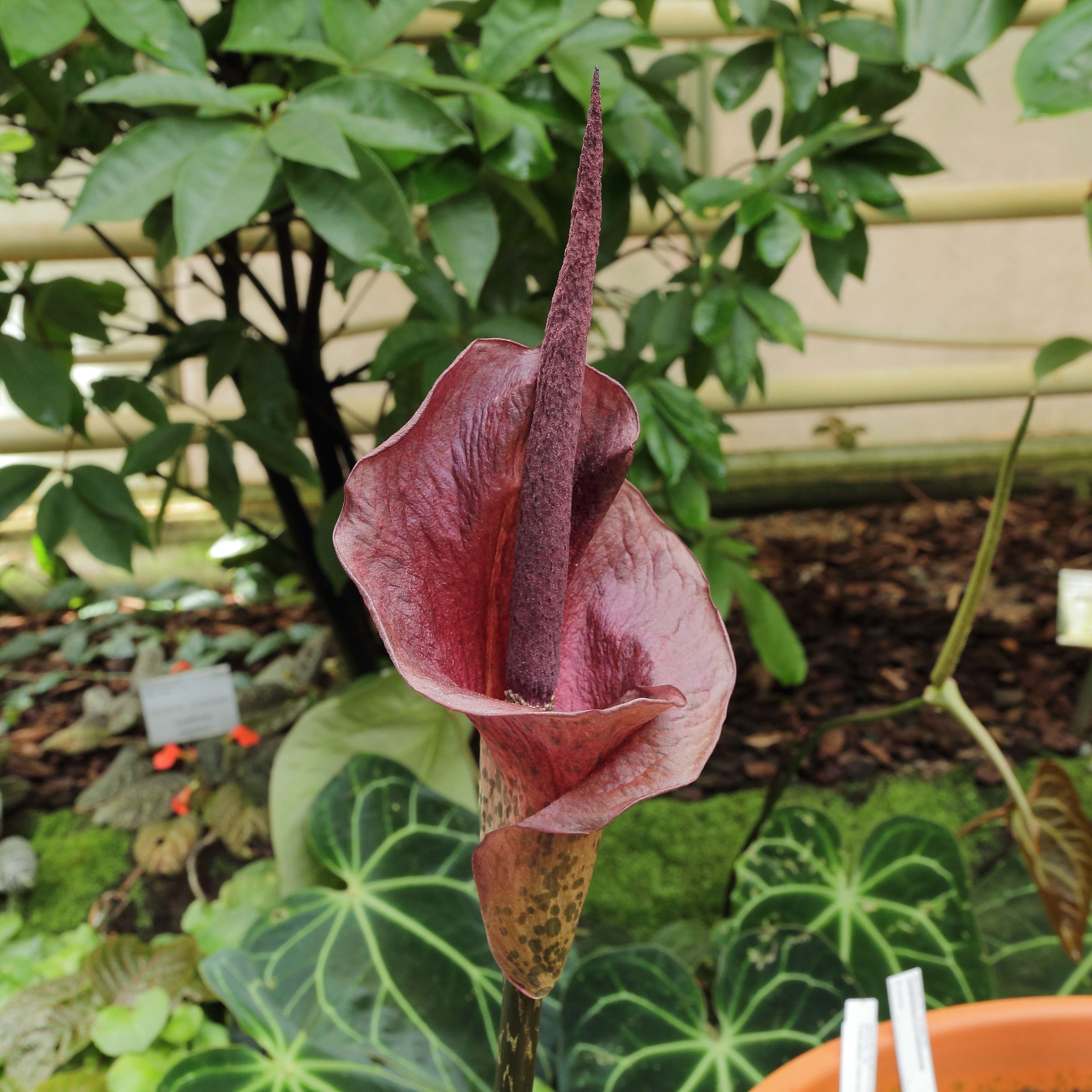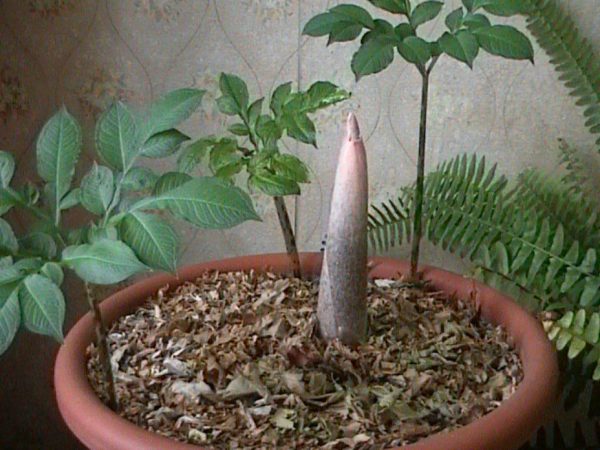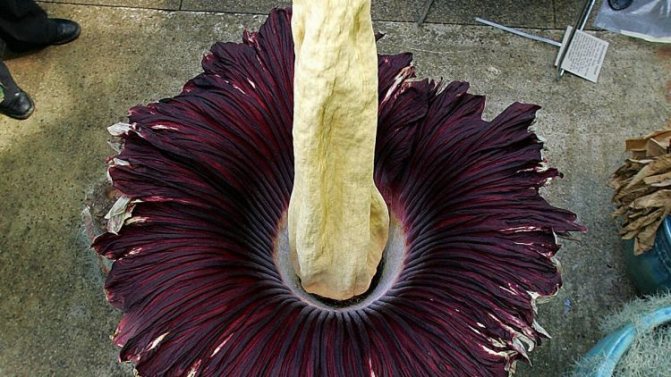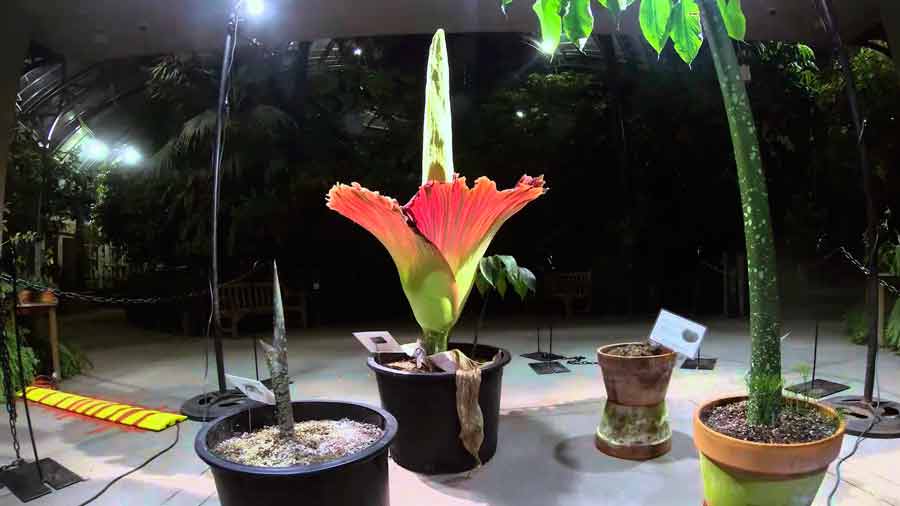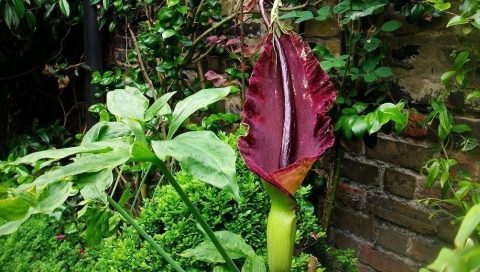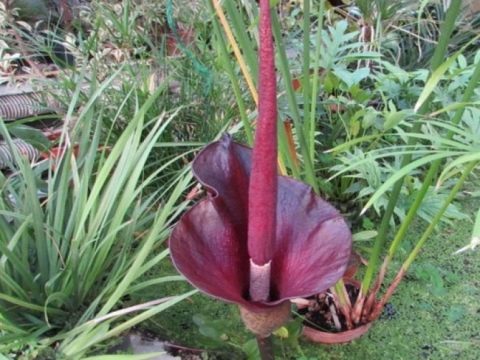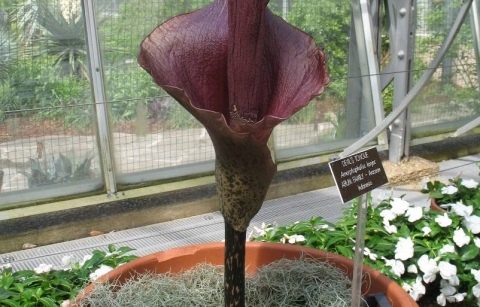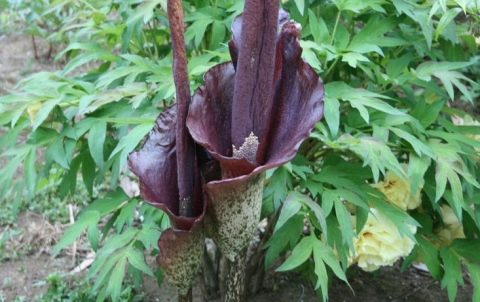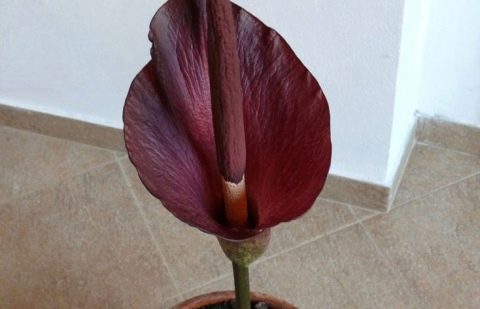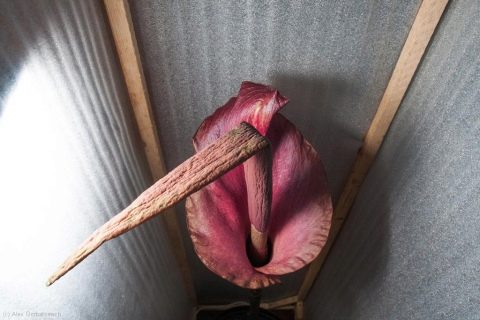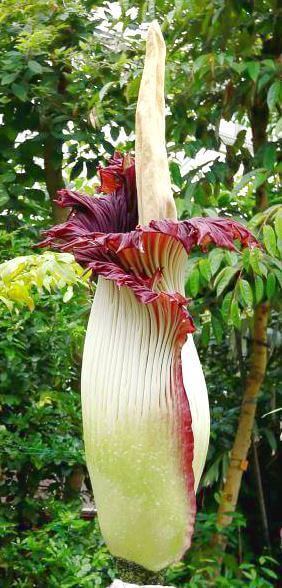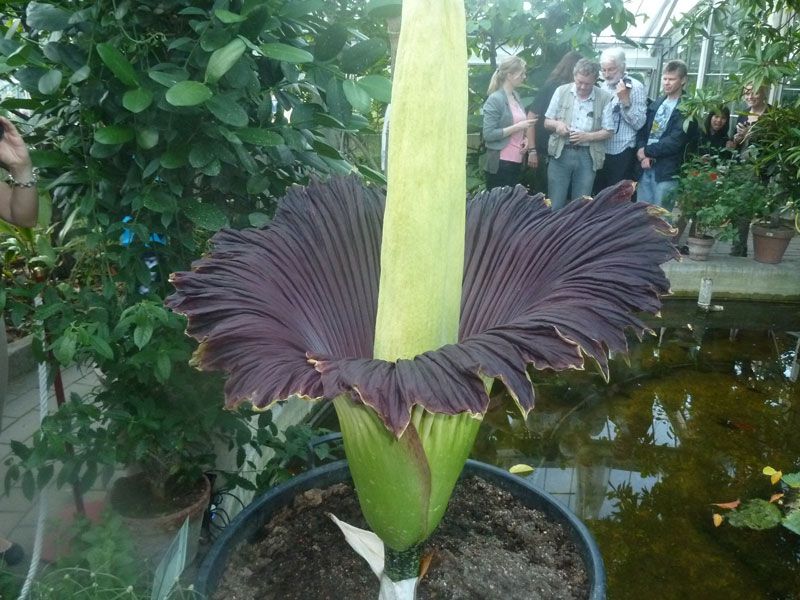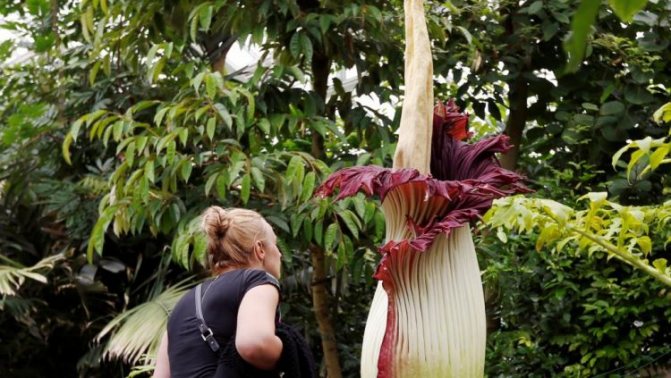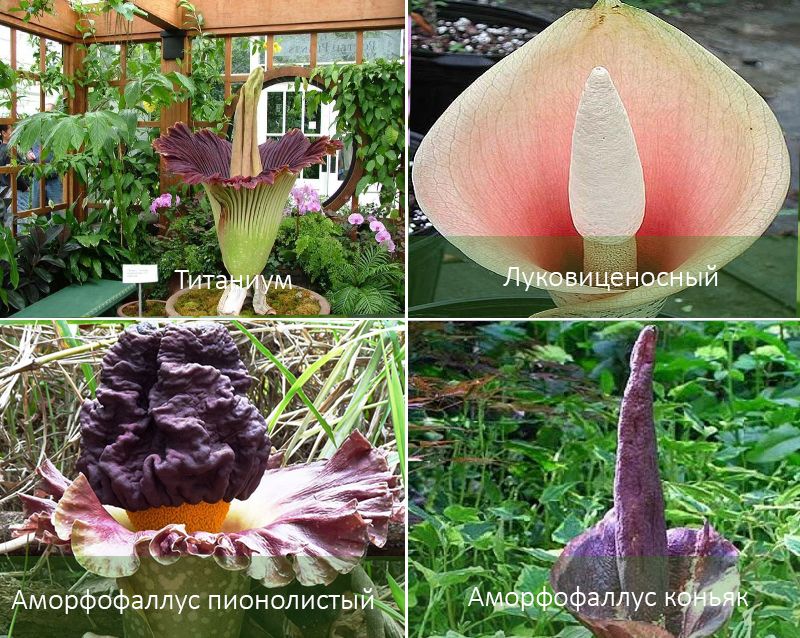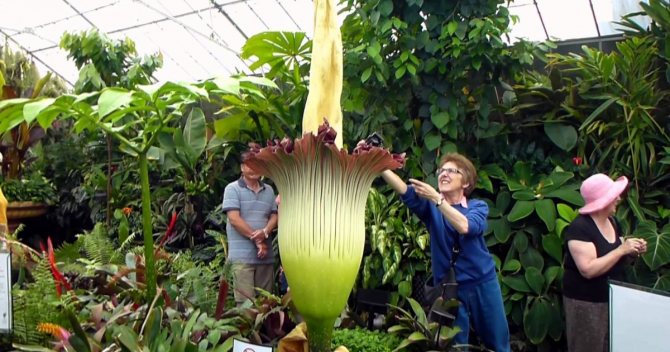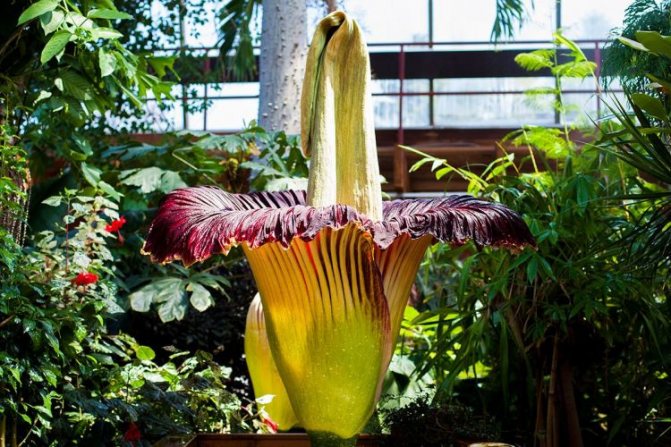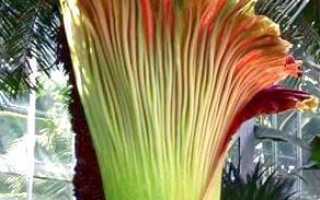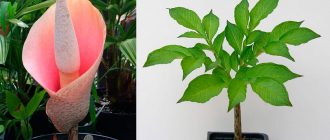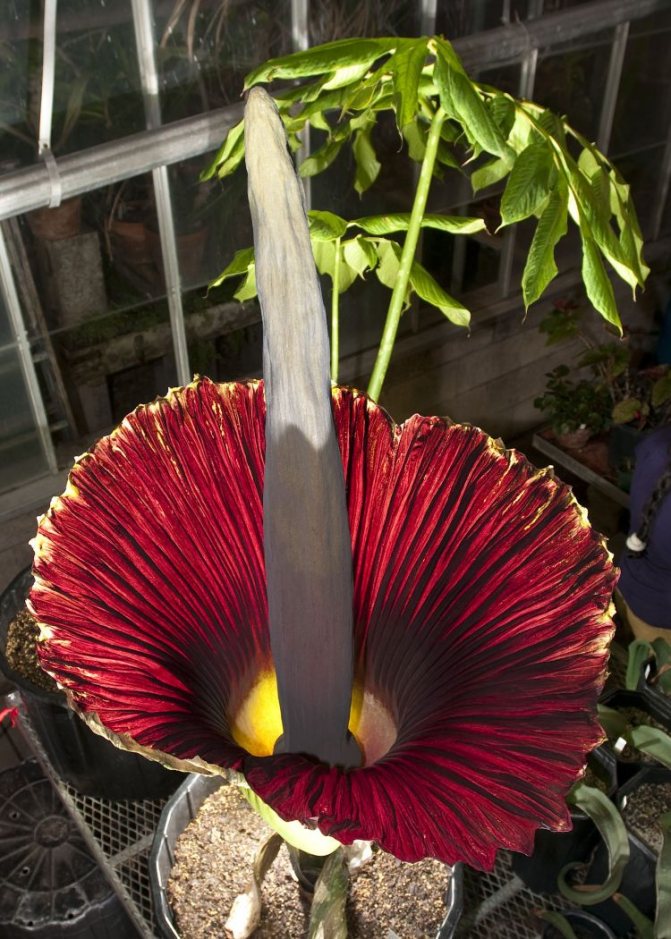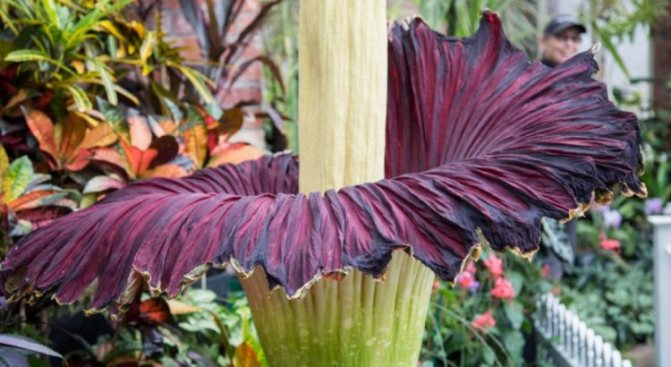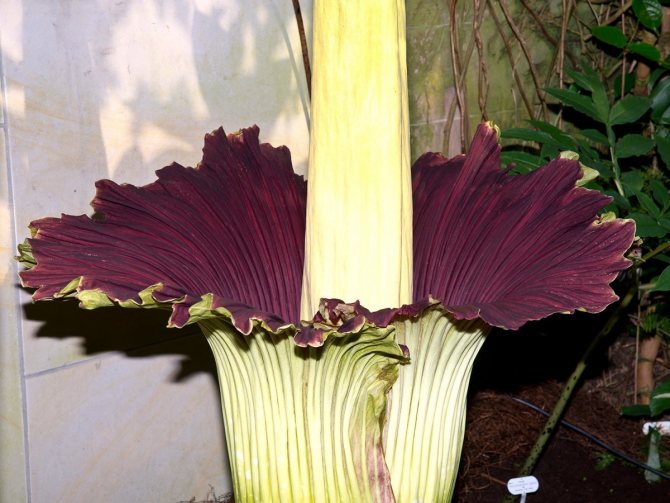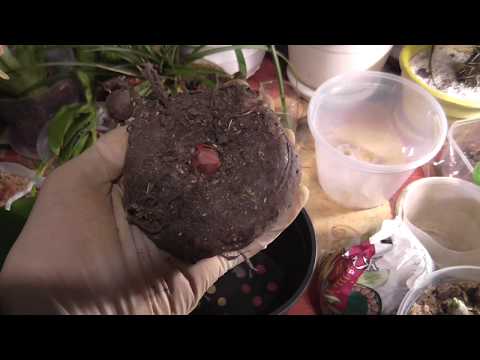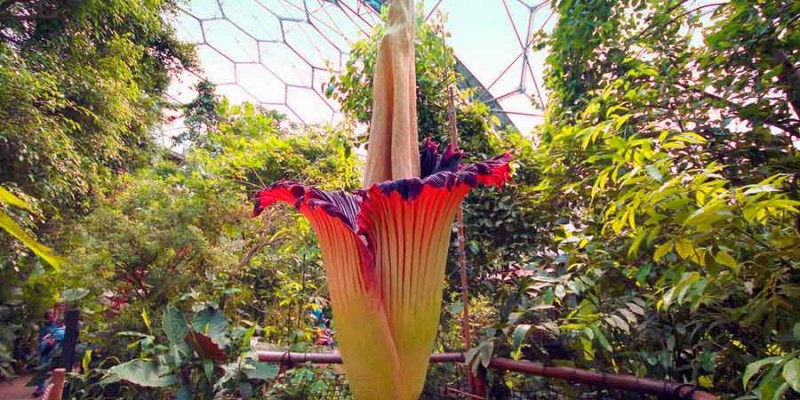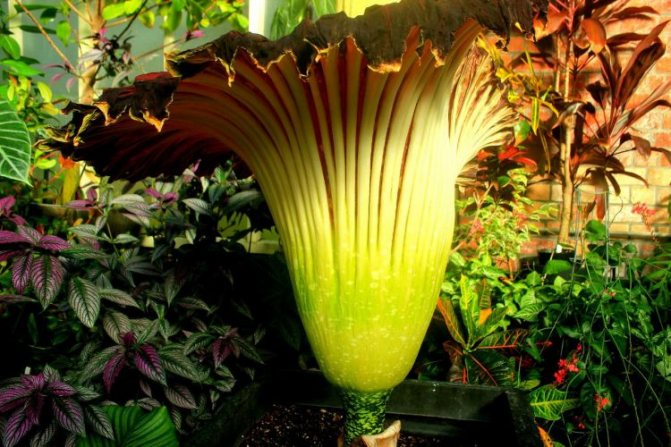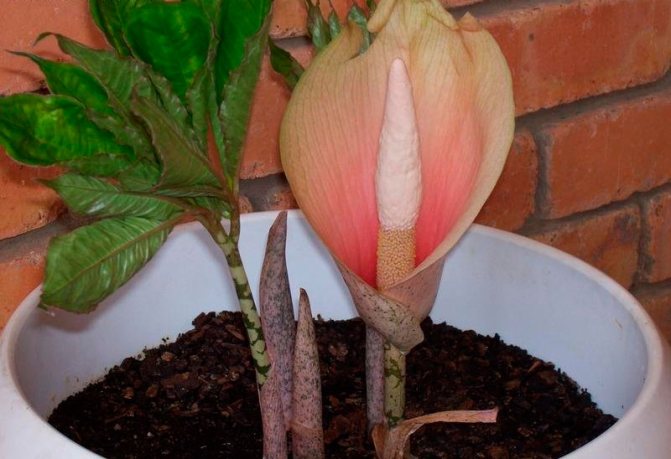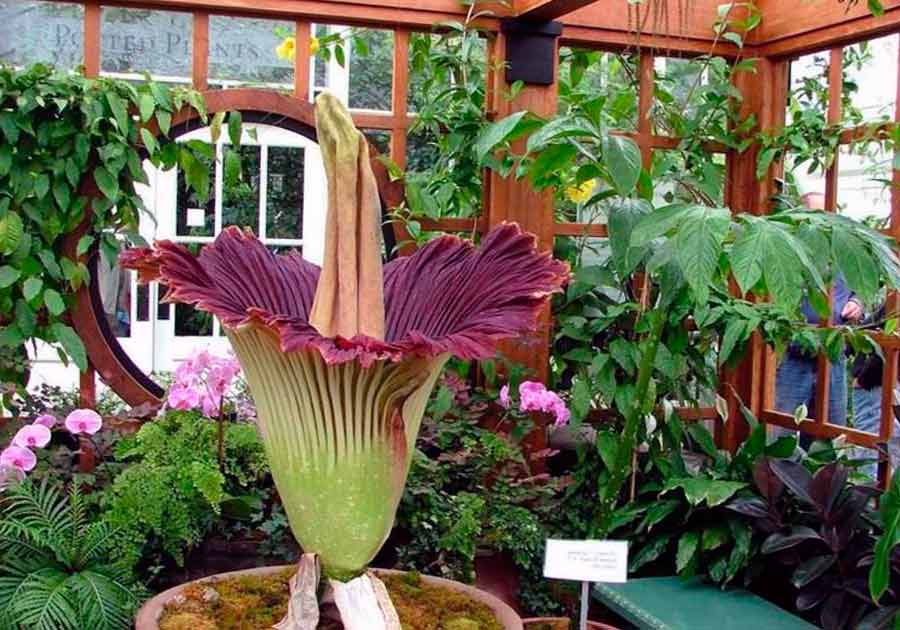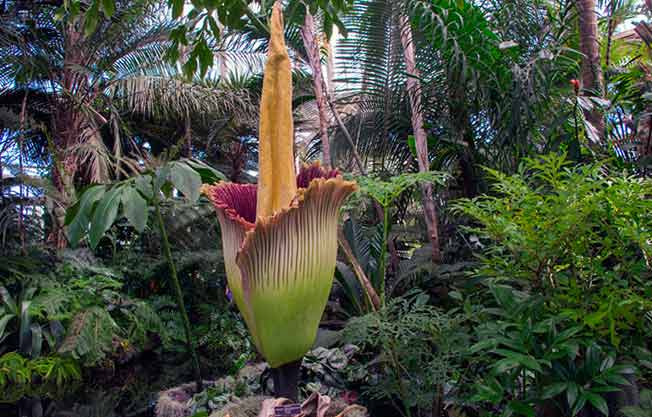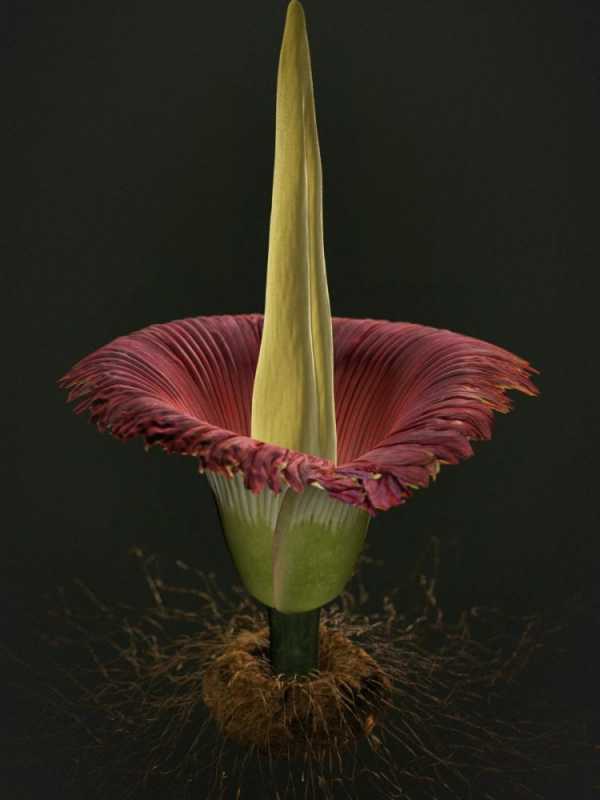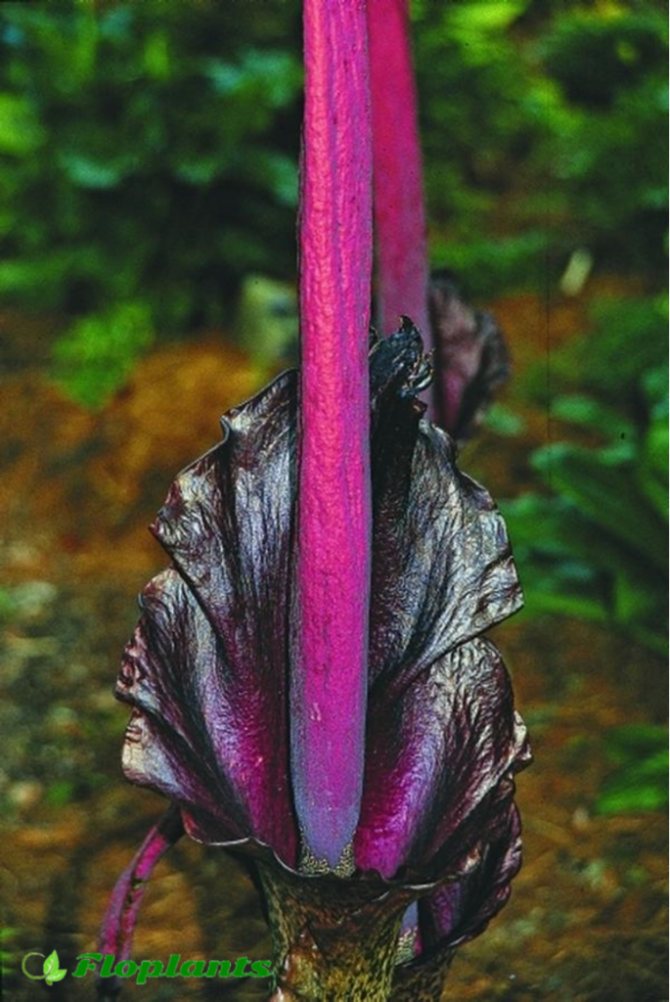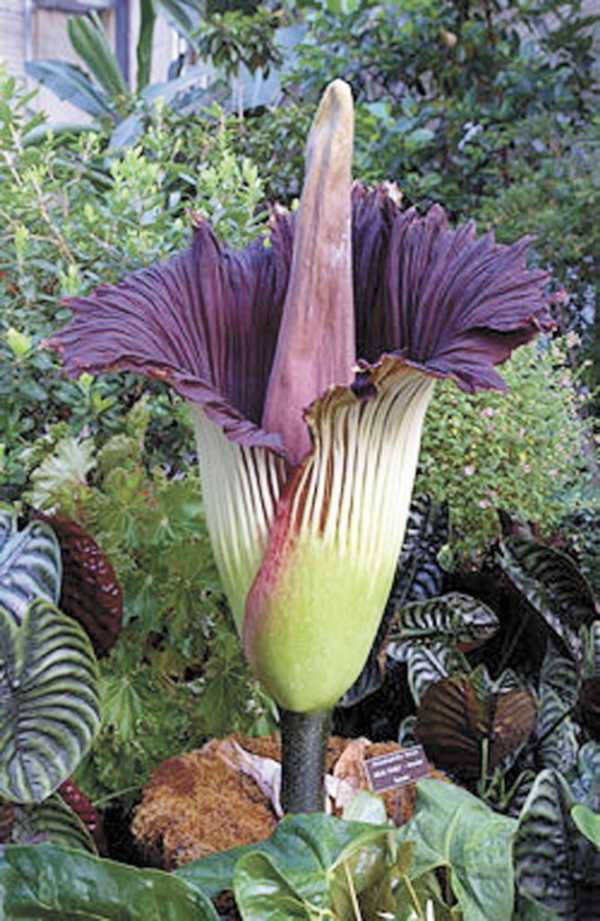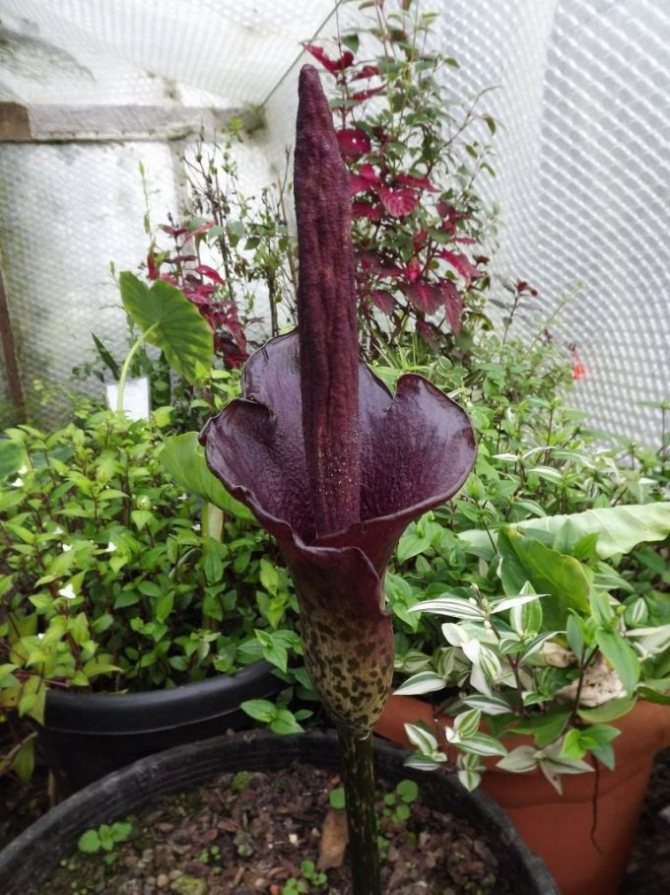Home care
Caring for amorphophallus includes feeding. Until August, the plant goes through a period of active development and growth. During this period, the soil for the tuber is fertilized with phosphorus. Regular feeding every two weeks.
In the summer season, the culture needs regular watering. As soon as the topsoil begins to dry out, add water.
The amount of liquid is determined as follows: it must come out through the drain and remain on the sump. You can empty the water from the pan after an hour. During this time, the plant will still absorb as much moisture as it needs.
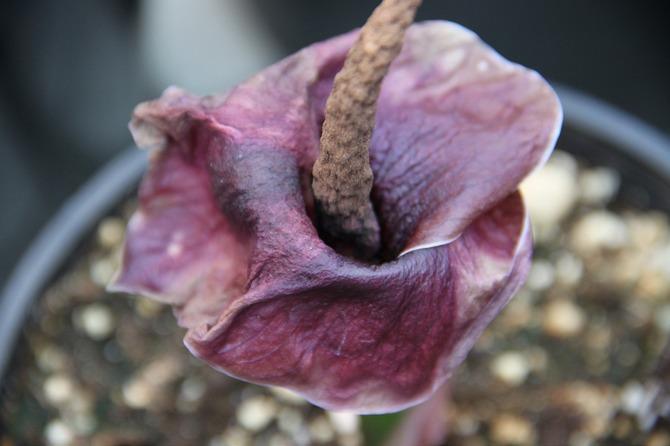
At the end of summer, the leaf turns yellow, dries up and disappears. This is the beginning of a state of dormancy in culture. During this period, the plant should be watered in small quantities and not often.
In the autumn period, the tubers are removed from the soil, the rhizome is examined. If rotten areas appear, then they are cut out. The process requires care so as not to damage healthy roots.
The sections are processed with charcoal. The rhizome is completely washed with a strong solution of water with potassium permanganate. The plant should dry out a little and absorb the substance.
Amorphophallus is placed in a box, you can use a container with sand. While the culture is at rest, it is left for storage in this form. The storage area must be dark.
The crop will show no signs until the end of the winter season. After that, shoots will begin to appear. Amorphophallus is planted in the soil.
It must contain: deciduous soil; humus; peat; coarse sand. A glass of fine manure is added to one bucket of such a substrate. The pot for planting is chosen several sizes larger than the tuber itself.
Drainage is placed on one third of the entire pot. Put soil at the bottom, filling half of the container. A hole is made in it and covered with sand.

Place the tuber of the plant in it carefully. It should not be planted too deeply. One third of the rhizome. Sprinkle the remaining roots with soil. The soil must be enriched with water. The pot is placed in a bright room.
Until the flowers and leaves appear, watering occurs as usual, after manifestation it intensifies and becomes abundant.
To protect against them in the summer, the culture is sprayed with soft water. You can use distilled. You can install a layer of expanded clay into the pan of the pot.
Reproduction methods
Often the “kids” method is chosen for reproduction. They appear near a leaf in an adult culture.
If the growing conditions are favorable for the plant, then the children in one season can reach the size of the culture itself.
Amorphophallus can be propagated by another method. Many growers do not even know that such a method exists.
In the active period of the flower, a small shoot is located near the leaf (more precisely, near its divergences). It is barely noticeable, so the hostesses often do not notice it.
When the leaf begins to dry out, and the plant is dormant, this tuber is separated from the mother's trunk. The place that was attached to the leaf is dried.
The tuber is planted in a small container. The sprout can appear instantly, or it can only do so in the spring. Each scion behaves differently.
After reproduction, amorphophallus will develop within five years. It will begin to bloom only after complete habituation.
For this, the flower takes more time. Within five years, one leaf will form on the trunk. The sizes will be added every year.
After the culture is saturated with nutrients, the tuber grows to thirty centimeters, the first inflorescences will begin to appear.
What diseases and pests is amorphophallus susceptible to?
In general, amorphophallus is a flower that is quite resistant to various kinds of diseases. However, when the plant is still young, it can be infected by aphids and spider mites. For prevention purposes, the leaves should be periodically inspected. If you find pests, treat the plant with an insecticide. Remember that you only need to process the leaves without touching the tuber, otherwise the amorphophallus may die.
The most common plant diseases are:
- rotting of the roots due to abundant watering;
- drying of leaves caused by a low level of lighting or humidity;
- the formation of bright spots on the leaves due to insufficient lighting.
Caring for amorphophallus at home is not so difficult. If the plant is provided with timely and systematic care, then it will delight you with its flowering for a long time. By the way, the roots of amorphophallus contain a large amount of useful elements, so some types of plants are eaten. However, it is not recommended to add such an unusual ingredient to your diet on your own: it is better to consult with specialists after all.
Features of the structure and growth
In the huge assortment of indoor plants, it is difficult to find a culture more original and intricate than amorphophallus. The name is derived from two Greek words that mean "Amorpho" - "formless" and "Phallus" - "shoot, shoot". This appellation successfully characterizes the cylindrical inflorescence that resembles an ear. The plant has unusual not only flowering, but also a way of life.
- A typical ephemeroid (short-lived) is dormant for a year longer than in active vegetation.
- The size and shape of the root system resembles a grapefruit. The tuber can weigh up to 5 kg.
- A thick palm-shaped stem grows out of it, with one single leaf of a complex structure. Characterizing the structure of the plate, botanists say that it is tripartite and twice dissected. The leaf has only existed for a few months. It appears on the stem at the end of March, grows all summer, and dies off in October. The next plate will be formed by the beginning of next spring. It forms on the trunk above last year's leaf. The size will be smaller and the cut will be larger.
-
The flower sprouts after the leaf and lasts for about a month and a half, then dies off. At a certain moment, a peculiar smell appears, reminiscent of the aroma of decaying flesh of mice or fish. For this plant received the name - "Cadaveric flower". Nature has endowed him with such a feature to attract insects, which are needed for pollination. In nature, the male flower blooms later than the female, so cross-pollination is rare. Because it is necessary that flowering occurs at the same time.
- There are cases when the flower is pollinated. Then, at the end of flowering, an infertility is formed, which consists of berries with a fleshy pulp. It contains seeds. If they are formed, the plant dies.
- Amorphophallus takes a lot of energy to form leaves and flowers. In this regard, he needs a short three-week vacation, immediately after he has faded. Unlike other plants during one calendar year, the culture enters a dormant state twice. Sometimes, after resting, a new leaf appears. And, it happens that hibernation lasts until spring.
- If, at the end of flowering, the fruit is formed, it consists of berries with a fleshy pulp. It contains seeds. If they are formed, the plant dies.
Varieties
In the world there are a variety of types of indoor plant amorphophallus. The difference between them is so great that it is difficult to tell at once whether such different plants belong to the same species.Wild specimens are distinguished by the power of the stem and gigantic size, while indoor species are an extravagant-looking flower with a minimum amount of green elements.
Cognac

Amorphophallus konjac
Amorphophallus cognac produces a tall flower that often reaches 80 centimeters even in indoor conditions. The inflorescence has a rich purple hue and consists of a process that holds a petal-veil in its arms.
After flowering, a leaf is formed, which has a split structure, classic for the species. With the arrival of autumn, the upper part of the plant dies off to resume by spring.
Reproduction of the cognac species occurs with the help of multiple processes that are formed on the flattened tuber.
Bulbous
A variety of amorphophallus that does not bear fruit in captivity. During flowering, an ear up to 30 centimeters long and a wide pink-colored petal-cover grow. The petiole has an interesting "camouflage" color.
The tree propagates with the help of small bulbs that grow at the base of the leaf. The life cycle of this species of amorphophallus resembles the development of the "cognac" variety: long periods of rest are replaced by a stage of active life.
Titanic
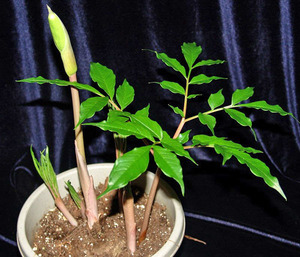
Due to its gigantic size, titanic amorphophallus is popular in greenhouses. The flowering period is especially spectacular, because the size of the inflorescence often reaches 3 meters in height and weighs about 70 kilograms.
The flower itself is a powerful ear that rises above the corrugated bedspread. The petal is colored green on the outside and has a bright and intense burgundy color on the inside.
The titanic amorphophallus flower ripens within a month, being in a closed position and exuding a strong unpleasant odor that attracts pollinators. The inflorescence opens up for just one night, after which it falls off, and the plant's forces are directed to the ovary of berries, if the plant is successfully pollinated.
How to create suitable conditions for exotic
A subtropical flower cannot develop normally without bright light. Make sure that direct rays fall on the amorphophallus only in the morning or evening. In the daytime, diffused light is needed. And in winter, additional lighting is likely to be needed.
Other rules for maintaining culture in a private house or apartment:
- soil mixture is poured into the flowerpot, which contains equal parts compost, sod soil and sand;
- alternatively, any substrate for home flowers is suitable;
- temperature regime - nothing supernatural: ordinary room conditions;
- in the resting stage, amorphophallus requires a dark place and a low air temperature (+ 10 ... + 13 ° C).
When the flower leaves to rest, you can leave the tuber in the same flowerpot or place it in a pot of dry sand. Other options are to dig up the onion and put it in the refrigerator for the winter (covered with sawdust) or take it to a dark, dry place. At the end of March, the amorphophallus tuber is planted in a new container. It should be larger than the old one.
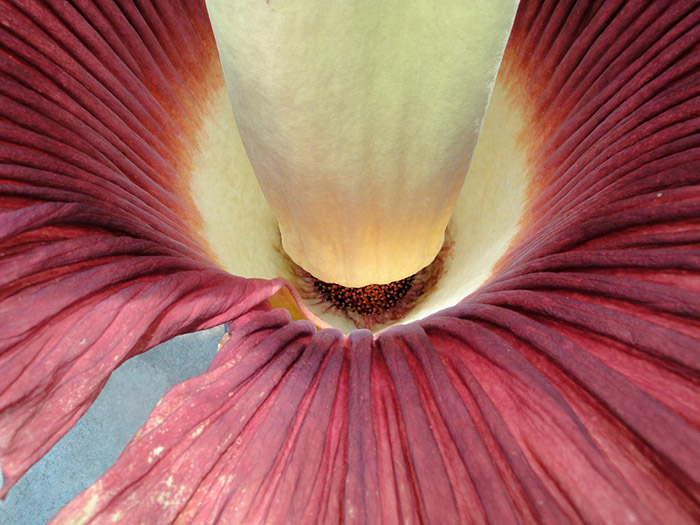
Application
There are tubers and other parts of the cadaveric flower should not be, because it contains a lot of poisonous substances. But this does not prevent the use of amorphophallus in folk medicine. The seeds contain the glycoside amorphine, which has a calming effect and improves the functioning of the heart muscle.
It is interesting that the amorphophallus flower is not afraid of growing in an area with an increase in the radiation background, a large amount of exhaust gases. Here the plant grows even faster and feels comfortable. In addition, improvements in air indicators with a diameter of several meters are recorded near the flower.
In pharmacy chains you can buy Fruticin tablets. The duration of treatment with them is from 20 to 30 days for the onset of a stable result.
Doctors of oriental medicine use the whole amorphophallus plant in its entirety to treat their patients.Flowers can relieve pain in the bones, are used for inflammatory diseases of the eyes. They can reduce heat. All parts of the plant are poisonous, you should not cook them yourself.
Home care
Despite all its exoticism, amorphophallus does not impose special requirements on the conditions. The basis of care is considered to be timely feeding during the active period, as well as observing the temperature regime during the rest period. Care features:
To create a "seasonal" climate, the flower must be provided with warm humid air during the hot season (+ 25 ° C), as well as lower the temperature in the autumn-winter period (+ 10 ° C).
For active life, amorphophallus is suitable for ordinary soil from a mixture of leaf, turf, peat and coconut components
It is also important to ensure that there is sand and humus in the soil.
The plant needs low or medium acidity of the soil.
It should be watered regularly during the period of active growth, as soon as the topsoil dries up. Water is introduced gradually, waiting until the moisture reaches the drainage, and then the sump, from where it is poured out, after half an hour.
With the onset of winter wilting, watering is gradually reduced, adding liquid only in order to avoid drying out the earthy coma.
Amorphophallus needs regular feeding, which will be based on phosphorus
To do this, you can use "Agricola" and similar products with a frequency of once every two weeks.


